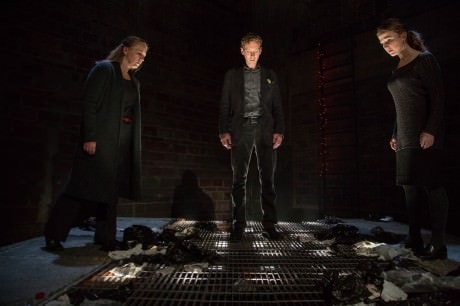No one should ever accuse The Studio Theatre of bowing to the pressure of getting into the holiday spirit. In this time of Islamic State and relentless “drones,” torture reports and rectal feedings, the killing of unarmed citizens (children, teens, and adults) by police officers–not to mention the once a week school shootings since Sandy Hook or the rampant sexual assault in the military and on college campuses or just your run-of-the-mill murders and armed robberies and rapes–a little bit of “Joy to the World” might be nice, if it didn’t make one feel so delusional.

Mark O’Rowe’s Terminus, now at Studio’s 2nd Stage, takes that sense of delusion to its darkest extreme, and it does so in a uncompromisingly brutal, if whimsical, if linguistic way.
One of the beauties of language is embedded in the old nursery rhyme:
Sticks and stones will break my bones
But words will never harm me.
In the case of Terminus its words “will never harm” us, and we are spared any physical portrayal of the tale. You will find no reenactments of the actions being told us by its three characters–no climbing of the crane in search of love, no death angels fighting against a belligerent, heroic demon soul, no love making between a man of worms and a lonely woman, and definitely no love making that ends in a brutal murder–such a “showing” would have most assuredly been too much for any non-sadistic audience to endure.
Instead, Terminus offers us three characters (A, B, C) standing in their respective spotlights and speaking their monologues of narrative poetry like rushing river rapids: their eyes full of pain as a betrayal is recounted, their cheeks full of glee as a life goal is realized.
And that is both the challenge and the wonder of Mark O’Rowe’s text, which I hesitate to call a script as its form and its manner of production bears far more resemblance to performed prose or poetry than to theatre.
Aside from its length, Edgar Allan Poe would have been proud of the writing–he believed the lyrical needed to be kept short and passionate. Terminus has a complex rhyme scheme much like Poe’s The Raven; that poem sings gloriously throughout its 18 stanzas, or approximately 9 minutes of verse.
O’Rowe’s Terminus has 9 such narrative poems that approach 2 hours to perform, and that’s at a breakneck speed that leaves the audience wondering how in the world these three actors maintained such a flood of phonemes without a pause or a sputter (okay, maybe a sputter here or there, but almost none).
The stories that the play’s logo-centric design weave together are a complex mixture of urban legend, Christian mythology, and Clockwork Orange savagery.
All three of the actors handle the challenges of the text with a wonderfully textured emotional presentation that shifts seamlessly from intense passion to somber loss to joy to hatred to fear to disgust.
You have A, a middle aged mother and school teacher, played sympathetically by Nanna Ingvarsson. Her character tells us about one of her students, Helen, as she prepares to have a late-term, back alley abortion at the hands of her lesbian lover, Selene, and her thuggish crew. Seemingly respectable, Ms. Ingvarsson’s character is anything but as her tale details her sexual betrayal of her daughter, her violent tendencies, and murderous impulses.
You have B, the daughter of A, a lonely, loveless, and desperate young woman played longingly by Katie Ryan. Her character tells us of her tragic demise: an evening that has all the trappings of love re-discovered, but that ends in treachery and death. Fortunately, for Ms. Ryan’s character, her death carried with it a phantasmagorical celebration of sorts, where the glories of soul-love and the wonders of eternity open to her.

You have C, an untalented man who is excruciatingly shy around women, played sickeningly (an oh-so-good “sickeningly”) by Dylan Myers. His character tells us of his decision to sell his soul to Satan so that he might have the talent of song. Unfortunately, his intense shyness remains, so that even though his voice is beautiful in every way he cannot sing around women. As a consequence, he becomes a serial killer of women (don’t worry, I don’t think these tales of the gruesome bear much resemblance to reality).
Director Tom Story has kept his actors focused on the anti-theatrical style: except for the occasional cradling of a baby or the stuttering walk on a crane, you will see no physical clues as to what has happened off stage. As these moments of verisimilitude are rare, here it’s the ears that get the workout.
Not even the set, designed by Deborah Thomas, will help with the text. A subway grate littered with debris with a train roaring underneath offers its own hermetic image. A pre-show iconic string of red lights ascending a beam center stage might provide a clue: a post-apocalyptic Christmas perhaps. When the stage lights come up and the play begins, the gesture toward Christmas goes off and never returns. Such is the way of this world: you will find no Christmas here in the kingdom of murder and mayhem.
Costume Designer Brandee Mathies gives each character an appropriate under-affluent look while Lighting Designer Adrian Rooney creates some absolutely fascinating shadows with up and down lighting. As sound designer, Mr. Rooney initiates the play with the loud, life-defying roar of a subterranean train.
Terminus is obviously not for everyone, but it is most definitely for the linguistically enamored. In fact, sometimes I found myself simply listening to the text’s finely crafted poetry and its rhymes popping in miraculous artifice.
Terminus would also be for the troubled soul, who is haunted by the terror of the world and its cruelty: not simply by its mindless violence, but by its humanity’s fiercest contradictions.
For the horror of Terminus might be unredeemable; but even in that person who deserves nothing but our scorn, who has crossed a boundary that should never be crossed, in his or her solipsistic self resides a salvation, a singular moment that makes all the horror worthwhile.
Such is the world of Terminus. Such is the world we have wrought.
Running Time: one hour and 50 minutes, without an intermission.
Terminus plays through January 4, 2015 at The Studio Theatre’s 2ndStage – 1501 14th Street NW, in Washington, DC. For tickets, call the box office at (202) 332-3300, or purchase them online.
LINK
In his column ‘Magic Time!’ John Stoltenberg on Terminus at The Studio Theatre.





